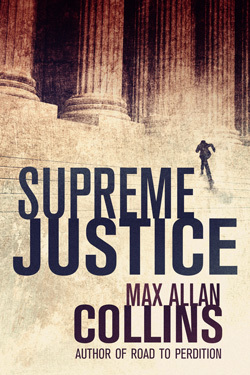Max Allan Collins's Blog, page 18
September 20, 2022
New Mike Hammer Book Giveaway & Encore For Murder
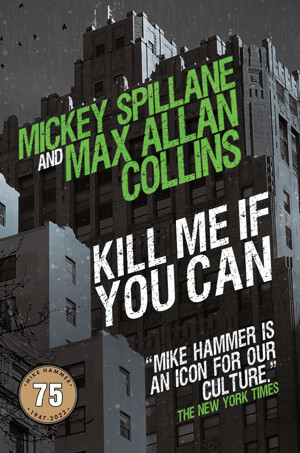
Hardcover:







E-Book:





Digital Audiobook:



Audiobook MP3 CD:




Audiobook CD:




As our celebration of 75 years of Mike Hammer rolls on, the new Hammer novel, Kill Me If You Can, is about to be published by Titan today (September 20).
We have ten copies of the book for the first ten who write me in exchange for a review on Amazon and/or Barnes & Noble and other review-friendly sites. Kill Me If You Can comes chronologically after Velda’s disappearance and charts (among much else) Hammer’s descent into depression and the bottle…and yet it’s a rousing good time! I promise. As a bonus I have included five short stories (two of them Hammer tales, significant additions to the canon) taking place in the “Hammer-verse.”
[All copies have been claimed. Thank you for your support! –Nate]
* * *I’m involved in many things to celebrate this 75th anniversary of the publication of the novel I, the Jury (1947), including this December the ClassicFlix release of the film I, the Jury (1953), with a 4K Disc as well as a regular and a 3-D Blu-ray. I’ve done a commentary for the film and also included a remaster of the Brian Keith/Blake Edwards 1954 Mike Hammer pilot film (with an on-camera wraparound). Wolfpack has already published The Menace by Mickey and me (a novelization of an unproduced horror screenplay), a collection of his three Young Adult adventure novels, including the previously unpublished title yarn, The Shrinking Island; and a terrific anthology of novelettes and short stories, Stand Up and Die!, which includes a Spillane/Collins “Hammer” story.
Still to come are an expanded, updated version of my 1999 documentary, Mike Hammer’s Mickey Spillane and the definitive biography, Spillane – King of Pulp Fiction by Jim Traylor and me coming out from Mysterious Press in January 2023.
The most quirky and (for me at least) particularly fun iteration of the Hammer celebration has been the local (Muscatine, Iowa) presentation of my Hammer play (from a one-page Spillane synopsis), Encore for Murder. We presented the one-time only performance on Saturday, September 17.
A generous array of photos accompany this update, and I will share some thoughts and memories about it. However, first I’ll mention that we recorded the production and will, at the least, be excerpting scenes (and a few cast interviews) from it in the expanded Spillane documentary.

Noted radio announcer Max Allan Collins introduces the play.
It began with a phone call from local theater maven Karen Cooney, who wanted to mount a play in the style of an old radio show as a fund-raiser for the local Art Center. She thought doing a Dick Tracy radio show would be fun and I, of course, was the logical person to provide the script and participate generally. I turned her down flat, saying I had no interest in promoting Dick Tracy, a property I was fired off of in 1993.
A few days later I called Karen back and said, “However – I have an existing Mike Hammer script in the radio style that you could use.” I explained that this was the 75th anniversary of Mike Hammer’s debut and I was looking for ways to promote that – particularly fun ways.
I told her that Gary Sandy of WKRP in Cincinnati fame had played Hammer in this play, Encore for Murder, at a mystery festival in Owensboro, Kentucky, in 2012, and again in 2018 at the prestigious Ruth Ekherd Hall in Clearwater, Florida. Gary’s involvement, and mine, grew out of his co-starring with Patty McCormack in my indie feature, Mommy’s Day.
Encore for Murder was originally recorded in 2011 for Blackstone Audio (in a longer version) by the great Stacy Keach and a full cast including Mike Cornelison and Tim Kazurinsky.

Rene Mauck as Velda with Gary Sandy as Mike.
Initially for this local presentation, I was going to read Hammer, and the production would be much like the Owensboro one, which was strictly actors at microphones with a sound-effects table in the orchestra pit. Karen wondered if Gary Sandy might consider coming to Muscatine to appear in our production. Somewhat reluctantly, not wanting to put a friend on the spot, I agreed to ask Gary and find out what it might cost to bring him in, because that would be a fund-raising effort unto itself.
I thought getting Gary to do this was a very long shot, but he not only immediately said yes, he refused any compensation (beyond expenses and lodging, which I insisted upon). This began to get me thinking about the more hybrid presentation we’d done in Clearwater, with costumes and more stage action, as well as a giant screen with scene-setting slides and musical cues, and a foley table right on stage to invoke the feel for a studio audience in the days of Golden Age radio.
Still, with a local amateur cast, I didn’t want to get carried away.
My role was co-director, basically letting co-director Cooney cast it (she knew local dramatic talent and I didn’t) and get the play on its feet. When Gary arrived, I would step in and fine-tune. When I went to the first table read of the script, I was pleasantly surprised by the level of the cast.
I went home and said to Barb, who was keeping her distance from this project, “Am I crazy, or could this cast actually be pretty good?” Her answers were “Yes…and maybe.” I begged her to go the second table read and give me her opinion. I read Hammer myself. Afterward, Barb said, “Yes, they’re good.”
From then on I went to all the rehearsals and read the Hammer role, to give the cast a sense of pace and tone. Karen wanted a table read with Gary on the phone, a conference call. Again, somewhat reluctantly as I hated to impose on him, I asked….and Gary wound up doing two table reads.
Gary Sandy does not do anything half-way.
We rehearsed initially in a small black-box theater at Muscatine Community College (where Barb and I had gone in 1966 – 1968, and I taught from 1972 – 1977). We were not able to get into the rather impressive Muscatine High School auditorium until the Tuesday before the Saturday show. Five days to mount and perform it.
Oh…kay….
Gary was coming in Wednesday, traveling during that day, and might stop by and say hi to the cast (all our rehearsals began at 6 p.m. as the school was using the theater till then – we would have to strike the set every time). We’d only have him Thursday and Friday before the Saturday performance. Making this truly problematic was our foley artist, Chad Bishop – studio manager of Muscatine Access Channel Nine – would be controlling the live action sound effects and the prerecorded ones too, as well as the audio mix and musical cues…all from on stage!
(I provided the Stan Purdy music from Mickey’s 1954 Mickey Spillane’s Mike Hammer Story LP, and from Chris Christensen’s score for the 1999 documentary.)
The pre-recorded sound-effect cues included things like tire squeals, crashing glass through a skylight, and a plethora of gun shots. Gary would have to conform to these prerecorded cues or unintentional hilarity would ensue.

Gary Sandy as Mike Hammer. Foley artist Chad Bishop at right, the full cast on stage throughout.
So I got very involved in the directing that first Tuesday night in the real theater space. I was on stage talking to Chad about his foley work and the difficulties they created, when I turned and found myself nose to nose with a grinning Gary Sandy.
After a six-hour drive, the unannounced Gary stepped right in and we ran the full first act, sound effects and music cues and all. The next night we ran the second act the same way. Much of this had to do with Gary coordinating with Chad. But it was thrilling, really was, to see this already very good cast get pulled up at least a notch by Gary’s performance level. I was already impressed by the way every single cast member took direction – because my experience is in features, I work on tweaks not broad strokes, and you might think local talent would have difficulty with nuance. In this case, at least, you’d be wrong.
Gary was not happy with the fedoras we had for him, and neither was I. I decided to try something very special. I have one of Mickey’s Miller Lite-era porkpie Stetsons that his wife Jane gave me – in a hat box with Mickey’s own writing on it. Gary’s mouth dropped open when I presented it to him in his dressing room and said, “If this fits, it’s yours…until after the performance.” Each time he wore it at rehearsal, he returned it to me in the hat box and I brought it again the next day. He only wears it at the open and close of the show…but for the play’s final lines, when he steps out very close to the audience, he looked amazingly like Mickey.

Mike Hammer (Gary Sandy) about to make his exit.
We had two dress rehearsals – Friday night and Saturday afternoon, with only a couple of hours between dress and the Saturday night performance. These were intense and I was tweaking the cast performances and my script throughout it all – some changes were made after the final dress rehearsal!
That dress rehearsal had gone well but not flawlessly, and I left wondering whether this was going to be a bullet train or just a train wreck. I was also concerned because we were up against a televised University of Iowa football game. I knew, from playing band jobs on such nights, audience size would be negatively impacted.
But the turnout was very good – three-hundred souls when we’d been under two hundred on advance sales. The silver lining was a V.I.P. After Party, meet-and-greet/Q and A at the great Merrill Hotel, which had sold out at fifty bucks a pop.
My longtime film/video collaborator Phil Dingeldein joined with Chad and his assistant Jeremy Ferguson in positioning stationary cameras around unobtrusively. Phil shot the dress rehearsals (often roving) and the live performance. He had not been to any of the other rehearsals and he, like Barb, was surprised by the cast and the level of this local production, done under tight, unforgiving circumstances, not to mention a nonexistent budget.
The audience loved it, laughing in the right places, drawing in breath at the tough action – our record was a standing ovation, or I should say Gary and the cast (including hilarious on-stage foley artist Chad Bishop) received a standing ovation.
Where do we go from here? I know we obtained footage that will give us some interesting new moments for the expanded documentary. Having Gary and his Velda (Rene Mauck) and Pat Chambers (Chris Causey) talking about playing these iconic roles alone is a big plus.
Phil, Chad and I will edit the performance together and then there will be hard thinking to do. On the positive side, we have a lot of footage, or “coverage” as we say in the feature film game. I would love to share Gary’s charismatic performance as Hammer, as to date he’s the only actor to perform as the character in a stage play; his take in Encore is amusing without being campy, able to spoof one moment and slide into genuine tough-guy menace the next. One thing I’m considering, if Gary gives his blessing, is including it as a bonus feature on the Blu-ray of the expanded Spillane documentary.
Obviously we have to see how well it comes together as a video presentation (it’s high-def and I already know Phil shot it well). Perhaps if people understand the context, and the small miracle of this local production (Muscatine is a town of 24,000 after all), they will find the experience entertaining and even worthwhile…particularly with a pro like Gary Sandy at its center.

Phil Dingeledin on the camera at ENCORE FOR MURDER, with Max looking on.
But can we, as filmmakers, capture the excitement and enjoyment of those in the theater that night?
Stay, as they say, tuned.
M.A.C.
* * *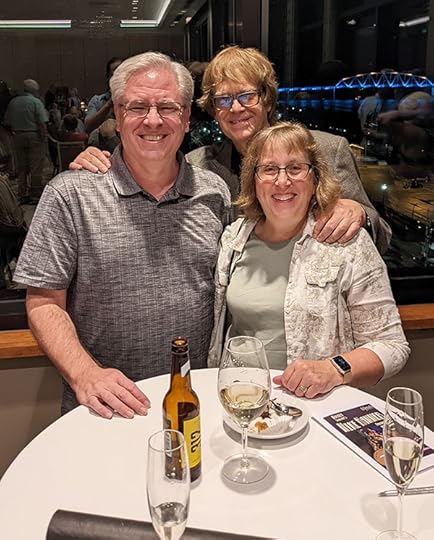
Fans who made the trip to Muscatine for ENCORE FOR MURDER: Mike and Jackie White.

Max, co-director Karen Cooney, and Gary Sandy at the V.I.P. after party.
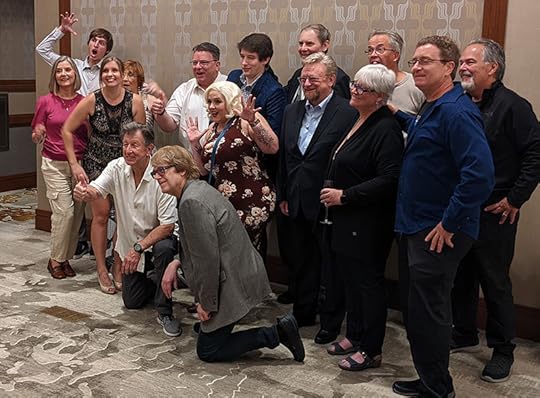
The cast of ENCORE FOR MURDER hams it up at the after party.

Max, Gary and filmmaker Phil Dingeldein at the after party.
September 13, 2022
Mike Hammer And Gary Sandy Come To Iowa

Purchase tickets here: https://macfriends.booktix.com/
Saturday, September 17, will be the one-time only performance of Mickey Spillane’s Encore for Murder starring Gary Sandy of WKRP in Cincinnati fame as Mike Hammer. The radio-style play will be presented at the Muscatine High School Theater, 2705 Cedar Street in Muscatine, Iowa. General admissions tickets are $15 apiece, plus a $3 processing fee for online ordering (tickets will also be available at the door).
Co-director Karen Cooney and I have been working with the cast for over a month, and now we go into a full week of rehearsals, with Gary joining us this Wednesday. By “radio-style” what I mean is a presentation in the manner of a Golden Age radio program with a studio audience. That means the actors, though in costume, will use scripts at microphones. A big-screen slide show presentation (40 images) will set the scenes.
A major highlight is the sound effects table, manned by filmmaker Chad Bishop, who also handles the music cues (and selected the slides). Chad brings humor and imagination to the on-stage creation of sound effects (a “foley artist,” in movie terms).
Speaking of movies, my longtime collaborator on film and video projects, Phil Dingeldein of Rock Island’s dphilms, will be shooting the Saturday evening performance (and two dress rehearsals). We will be using footage – both performance and behind-the-scenes – in the coming expansion of my 1999 documentary about Mickey Spillane. We may be doing a shorter documentary on the production itself, and there’s a long shot chance we might be able to put the entire production together as a video program.
As Phil says, “We’ll see what we get.”
The talented cast is entirely local, with several actors veterans of Bishop’s indie film The Man in Purple (it’s on You Tube), about Norman Baker, the Muscatine Depression-era cancer quack who I fictionalized in the Mallory novel, No Cure for Death (1983).
Gary’s tough, wry take on Hammer was first presented in productions of Encore for Murder in Owensboro, Kentucky, and Clearwater, Florida.
Everyone involved has worked hard to make this a special production. My weekly update goes out all across the country (and beyond), so this local production may seem a little esoteric for those of you too far away to consider going. But it’s a fun part of the 75th anniversary of Mike Hammer and, with luck, will play nicely into the expanded Spillane documentary (and possibly other forms).
Short update this week! Lots to do getting ready for Mike Hammer and Gary Sandy coming to town.
M.A.C. and co-director Karen Cooney on Muscatine in Focus
M.A.C.
September 6, 2022
Encore For Paula
Last Thursday (Sept. 1) I appeared on the Paula Sands Live at KWQC TV in Davenport. Paula’s hour-long Monday-thru-Friday show is extremely high-rated in the Quad Cities market, and she herself – also the nightly news anchor – is celebrating an astonishing forty years at the station. (I accuse her regularly of having an aging portrait in the attic.) This was my first TV shot post-Covid lockdown, and it felt like coming home.
 [Click here for the video of M.A.C.’s segment on Paula Sands Live.]
[Click here for the video of M.A.C.’s segment on Paula Sands Live.]As some of you may recall, Paula Sands Live (or a satirized version thereof) appeared with Paula as herself in my movie Mommy’s Day. She was a major character in the film and did a terrific job. Also in that film was Gary Sandy, co-starring with Patty McCormack of course; Gary’s upcoming appearance in Encore for Murder as Mike Hammer on September 17 at the Muscatine High School Theater grows out of my friendship with him when he shot his scenes right here in Muscatine, Iowa, in 1996.
Gary is generously donating his time, reprising his performance as Hammer in the radio-style play Encore for Murder (we originally presented it several years back in Owensboro, Kentucky, and later at Clearwater, Florida), in this one-night-only benefit for the Muscatine Art Center.
Here’s the info, in case you missed it, for those of you close enough to this area (or crazed enough to drive or fly here).
We had our second table read via phone with Gary and the full cast on the evening of the day I appeared on Paula Sands Live. It went very well and the production is really coming together. The cast assembled by co-director Karen Cooney is excellent, and we have Chad Bishop (himself a filmmaker among his many talents) as the foley artist, which is a big, entertaining part of the play, as old-fashioned radio sound effects (and some newfangled computer effects) are generated right on stage.
We are planning to shoot footage at several rehearsals and the performance itself for use in the expansion of my 1999 Mickey Spillane’s Mike Hammer documentary, which is part of what I’m planning for the ongoing 75th anniversary of Mike Hammer celebration. We already have a video distributor lined up (which will include streaming).
And speaking of Mommy’s Day, my filmmaking partner Phil Dingeldein and I are remastering Mommy and its sequel for another Blu-Ray release. We have vastly improved visuals and will return to the original 4:3 format as intended. For those of you who have bought the movies before, well, uh…thanks! But we are just trying to get the best versions out there so that we can appeal to more streaming services and make the physical media as doggone good as we can.
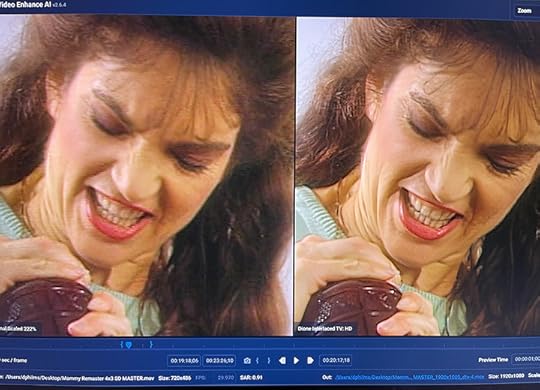
And speaking of physical media….
So, all of you film and TV fans, remember when we were told that physical media – that journey from Betamax and VHS to laser disc and DVD, and more recently Blu-Ray to 4K discs – would soon be a thing of the past. Would die a much deserved death, because after all everything we could ever want to see will be permanently available in the “cloud.” It’ll all be out there, childishly simple to access, thanks to the wonder of (drum roll please) streaming services.
This is where you are free to either (a), laugh derisively, (b), laugh maniacally, (c), swear and pound a fist on a table or desk, (d), sit morosely staring into space, or (e), find a quiet corner to sit in and weep. (“All of the above” doesn’t seem a practical option, but attempt if you wish.)
After all, we now know several things about this Brave New Streaming World. Well, first it sucks. Sucks money from each of us and just plain sucks. But admittedly it offers a lot of options, if mostly taking the old So Many Channels and Nothing Is On paradigm to ridiculous heights/lows. But all of these streaming services offer their selection options for a limited time. Sometimes, as with HBO Max, they break promises to subscribers like a popular girl in junior high in 1960 (but I am not bitter).
Yes, movies and TV shows are out there somewhere in the ether, just not where you can access them.
Meanwhile, Blu-ray and 4K chug somewhat expensively along, and break the backs (or anyway banks) of film and TV buffs trying to build their non-cyber library. And yet what a wonderful thing a non-cyber library is. For me, my collection of DVDs, Blu-Rays and 4Ks are (nearly) as important to me as the thousands of books I’ve accumulated in my lifetime.
Now I am not against Kindle and Nook and other methods of reading books on little monitor screens. Some people even read books on their phones, probably the same troubled souls who watch 4K movies on those tiny screens, unless they are carrying large flat screens in their pockets and purses in the pursuit of making their lives seem even more absurd.
I am tolerant of Kindle especially because I have made much more money in recent years from e-books than from what I like to call real books. God bless people for utilizing that tool. And I am obviously berating the streaming services even as I seek to sell my wares to them. But here is a wonderful irony – several of the generations younger than mine (actually, that’s more than several) prefer to buy, read and collect physical books. Kindle use is much, much more predominant among older people, the kind of people still wondering when those flying cars are going to get here.
Listen, Kindle has its place. If I were in a big city commuting, I would be using the one that is gathering dust somewhere in this house (it was given to me by the Thomas & Mercer folks). But I like media in physical object form. I like to hold a book in my hands. I like to study a book’s cover (not the covers of most recent books, which are by and large cold and hideous beyond belief) and delight at how it reflects the book at hand (or bitch about how it doesn’t). I even like the smell of books. And I like the way DVDs and Blu-Rays and 4Ks have pictorial jackets and can be lined up on shelves like books with spines and everything. I am resolutely old-fashioned in that regard, and delighted that so many people younger than me are reading books not on glowing screens.
But glowing screens played an interesting role in all this. Yes, it’s annoying that people have their faces in their phones, and it will serve them right in thirty years when their radioactive noses fall off and they have to go searching for them in the dark (the detached noses will glow, so will be easy to find, don’t worry).
But it was Harry Potter, thanks to the now reviled J.K. Rowling, and the much criticized cell phone that taught several generations to read again. They read those Potter books, actual physical books, and on their phones they read (“read” both past and present tense here) e-mails and texts, and they write them, too. Like people used to write letters.
When I hear people of my generation say, “These kids don’t read today,” I think: that’s what old people were saying when I was a kid; and statistically more old people are reading on Kindles rather than actual books, so what are they talking about?
I find the return to vinyl interesting if odd, since I have loved CDs for their lacks of skips and crackles for decades now. But the CD is old-school physical media that truly is dying, because downloadable music is more closely infinite than the very not infinite “availability” of film and TV from the streamers. Downloadable music is the enemy because it has people creating their own play lists and the art of the album is damaged and maybe dying (you know, like most of Sinatra’s Capitol catalogue and Rubber Soul and Pet Sounds and My Aim Is True and the first Vanilla Fudge album and Weezer’s green album).
So it’s a mixed bag, and it will not sort itself out (if it does) while I am still here.
My son Nate – who is selling a lot more books with his Jo Jo translations than I could ever dream of – has a wonderful idea that I hope he carries through on. He wants to write a blog where each week or maybe day he plucks a random disc from my endless DVD and Blu-Ray collection and watches (and then reviews) it. These will be things he did not watch with me while I was on the planet. I will now walk across the room to a bookcase of Blu-rays, and a spinner of DVDs, and pluck five things at eyes-closed random.
Here are Nate’s first five columns. He will discuss:
The Bowery Boys Volume Four (okay, I cheated on this one); The Halliday Brand (a western directed by Gun Crazy’s Joseph Lewis; An Angel for Satan (with Barbara Steele); Haunt from Scott Beck & Bryan Woods (the Quad Cities boys who made good with A Quiet Place, and unlike the Bowery Boys a genuine chance selection); and Ernest Scared Stupid.
Man would I like to read that column.

THAT’S MY BOY! Translator Nate Collins’ shelves of Jo Jo’s Bizarre Adventure at the Davenport BAM!* * *
Here’s a nice write-up on the upcoming Encore for Murder.
Ms. Tree is on this cool list from Punk Noir (great name); but there’s an inaccurate suggestion that I’ve written more than just the one Ms. Tree prose novel for Hard Case Crime.
Finally, this Wealth of Geeks essay discusses the merits of ignoring canon in films from a book (or comic book) series, and uses Mike Hammer to demonstrate. Good piece.
M.A.C.
August 30, 2022
Hear Me If You Can
The Skyboat audio version of Kill Me If You Can is available now, ahead of the September 20 release of the Titan hardcover edition. Stefan Rudnicki again narrates the novel as well as the five bonus Spillane/Collins short stories (two of which are Mike Hammer yarns) that are part of the 75th anniversary package.
I can’t say enough about the great job Stefan does. Having to fill the shoes of Stacy Keach is hardly an enviable job, but Stefan pulls it off. Skyboat has been a big supporter of my work, and recently signed to do new audio versions of Regeneration and Bombshell by Barb and me.
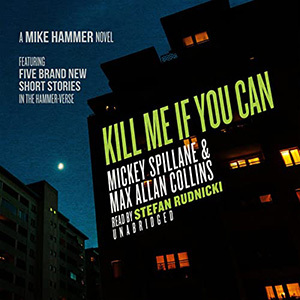
Digital Audiobook:



Audiobook MP3 CD:




Audiobook CD:




* * *
Rehearsals are heating up for our local Muscatine, Iowa, presentation of Encore for Murder featuring Gary Sandy as Mike Hammer. (For those of you in the area, or considering a road trip, here’s the info.
We had a table read with Gary joining us by phone – a conference call set-up – and it went well. My co-director Karen Cooney has done a great job casting and getting the show on its feet. I’m getting more involved now, doing some fine-tuning, but this is a strong local cast and I’m very pleased. Karen and several others of us mounting the production were able to look at the auditorium and do some in depth planning – it’s a great venue, seating 600.
We start working with sound effects and music (the latter culled from Mickey’s 1954 record album, Mickey Spillane’s Mike Hammer Story) this coming week, with a second Gary Sandy table read on Thursday.
* * *A number of things are coming out soon – the aforementioned Kill Me If You Can and, on Oct. 4, Antiques Liquidation, which just got a snark-free review from Kirkus. Check it out:
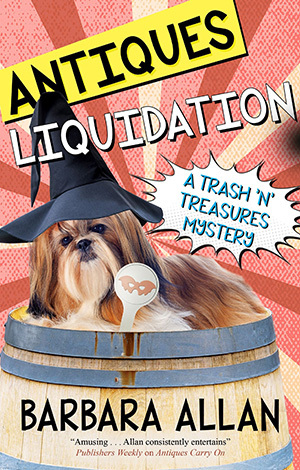 ANTIQUES LIQUIDATION
ANTIQUES LIQUIDATIONBY BARBARA ALLAN
The mother-daughter pair of Vivian and Brandy Borne may appear to be simple antiques dealers, but there’s more to them than meets the eye.
When Vivian wakes Brandy at 2 a.m. to get a jump on a warehouse full of things that are going to be auctioned off soon—thanks to some sensitive information Vivian has about Conrad Norris, the auctioneer—Brandy gathers up her dog, Sushi, and they all drive to the warehouse where Norris awaits. They leave with a barrel of pearl buttons that Sushi picks out, two valuable toy arks, and a set of dishes. When the auction itself takes place, Norris is drunk and many people are left unsatisfied. Vivian does buy something, though—she couldn’t resist attending the auction, even having picked off some items beforehand—and when she and Brandy return to the warehouse to pick it up, they find Norris dead. Naturally, Chief of Police Tony Cassato—Brandy’s fiance—is called in. Vivian fancies herself a sleuth, and she and Brandy have solved quite a few murders together—a fact that does not incline Tony to want their help. Vivian drags Brandy along on her investigations, knowing that Norris was far from beloved by many people. Someone steals the ark Brandy had given to her best friend’s daughter, but Brandy is hesitant to finger the two collectors she knows fought fiercely to buy the remaining arks at the auction. Vivian and Brandy may be amateur detectives, but they know a hawk from a handsaw and are determined to track down the killer, especially once a skeleton is found in their button barrel, opening up a long-dead case.
Amusing mystery chockablock with antiques lore.
We intend to have book giveaways on both Kill Me If You Can and Antiques Liquidation, so stay tuned.
Before too very long we should be seeing the publication of Fancy Anders for the Boys and Cut-out from Neo-Text. These will be available both as e-books and physical books. (Cut-out is a Barbara Collins and Max Allan Collins collaboration.)
And the new Nate Heller, The Big Bundle, will be out in hardcover from Hard Case Crime in early December.
I am about to begin the writing of Too Many Bullets, the RFK assassination Heller novel, after months of research. Those months will mean that the flow of books out of here will lessen next year, probably to just three. Some of this has to do with me deciding to slow down because I’m (damnit) 74. Some of it has to do with the amount a research that goes into any Heller novel, but this one has been unexpectedly onerous.
Like a lot of Americans, I assumed the Sirhan Sirhan assassination of Robert F. Kennedy was an open-and-shut case. I knew there were doubts and expected to explore them. But I did not (although I should have) expect the number of rabbit holes I’d be drawn down into.
After filling three notebooks, I have fashioned a rough synopsis, which I will be refining and expanding starting this afternoon. I hope to be writing this week.
As I’ve mentioned, I had intended this novel to cover Jimmy Hoffa material in a lengthy (middle section of the book) flashback. But as an echo of what happened to me writing True Detective in 1981 and ‘82, I found myself facing a book of potentially 1000 pages and had to retool.
(What happened with True Detective is that it turned into two books, the second one being True Crime, the first section of which was planned as the final section of True Detective.)
So Hoffa will probably become a separate book, out of chronology (although there hasn’t really been a linear chronology for Heller since after Neon Mirage).
I know some of you would prefer I write about Quarry or even Nolan (a few still request Mallory). I will indeed write about Quarry again, if I’m able, though I’ve stuck a fork in Nolan with Skim Deep. Of course, if the Lionsgate production of a Nolan film actually happens, I’ll be tempted to sell out. There’s always another story to tell if there’s money involved.
Mallory seems almost certainly a “no.” He was too on-the-nose “me.” I prefer the slightly off-kilter “me” of Heller and Quarry. And of course I’m occasionally called upon to channel Mike Hammer.
* * *Speaking of Nate Heller, here’s an essay that includes the Heller saga as among the best novels that deserve to be made into TV shows.
Road to Perdition is recommended as one of the best movies to watch on Paramount+ right now.
An in-depth and very positive overview look at my series of Quarry novels – something that has rarely been done – can be found here.
M.A.C.
August 23, 2022
Encore for Hammer
The 75th anniversary of Mickey Spillane’s Mike Hammer is really kicking in. Introduced in 1947 in I, the Jury, the private eye changed the nature of tough heroes even as his creator changed the face of publishing.
Not surprisingly, I’m in thick of that celebration, with Kill Me If You Can coming out next month. The novel is based on an unproduced teleplay written by Mickey in 1954, and it’s the bridge between Kiss Me, Deadly (1952) and The Girl Hunters (1962). Velda – his secretary/partner and the love of his life – goes missing, possibly killed, and Hammer wants to know why.
The book includes five short stories completed by me from Spillane material, two of which are Hammer yarns with particular significance to the canon.
In 1952 Mickey sold the film rights to the existing Hammer novels to expatriate British producer Victor Saville. The ink was barely dry when they began to feud over Mickey’s desire for input, including casting. Saville manipulated and handled Mickey, making promises he had no intention of keeping, i.e., casting Mickey’s cop pal Jack Stang as Hammer (who wound up with a bit as a pool hall thug). For that reason Mickey came to dislike the films Saville made and, frankly, Hammer’s daddy wasn’t always fair to those films, criticizing them in public. Taking the brunt of that criticism has been the 1953 I, the Jury with Biff Elliot.
The film has also long been dismissed by some critics (including latterday noir buffs) but they – and Mickey – are wrong. It’s a wonderful though hardly perfect movie, suffering from censorship woes but still a fine translation of Spillane to the screen, really capturing the feel of the early novels. Very few films noir were shot in 3D and this one was the work of cinematographer John Alton, widely considered the finest noir director of photography of the classic period. And only a couple of noirs were made at all during that first 3D wave.
For years now, the only place you could see the 3D version of I, the Jury was at an occasional film festival (I saw it in London at the Spillane retrospective where we showed my documentary, Mike Hammer’s Mickey Spillane, 1999). And the film is a wholly different experience in 3D.
Now ClassicFlix is bringing out an elaborate Blu-ray that includes a 3D disc (for those of you who have the capacity for 3D) but also a 4K disc and a Blu-ray. Seeing it in 4K is almost like seeing it in 3D. Here’s the terrific cover.
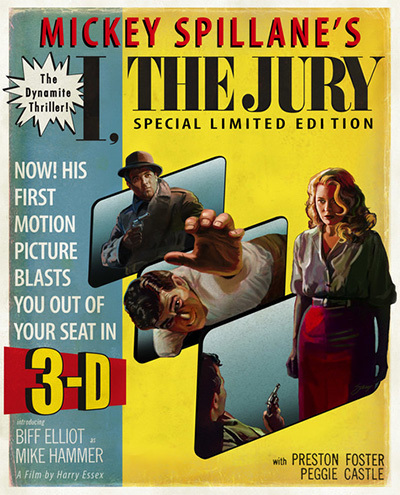
I have recorded the commentary and also have contributed a new transfer of the rare 1954 Brian Keith Mike Hammer pilot written and directed by Blake Edwards. My pal Phil Dingeldein and I created a new wraparound for the pilot that puts it into historical context.
Additionally, Phil and I are working on an expanded version of my 1999 Spillane documentary, Mike Hammer’s Mickey Spillane, bringing the story of Hammer and Spillane up to date. It will be a companion piece of sorts to the biography Jim Traylor and I have written (years in the making!), Spillane – King of Pulp Fiction, which comes out in January from Mysterious Press, and includes a lot of rare pictures as well as personal memories of mine set off in Spillane-appropriate italics.
We already have a distributor interested in doing both a Blu-ray of the documentary and getting it out to the streaming services.
As I’ve mentioned here I am also co-directing (with local theater maven Karen Cooney) a one-night presentation of the radio-style play, Encore for Murder, starring Gary Sandy (of WKRP In Cincinnati fame) as Mike Hammer. The production, an otherwise amateur one but with a strong local cast, is a benefit for the Muscatine (Iowa) Art Center.
Gary and I presented Encore for Murder in Owensboro, Kentucky in 2010 as part of the International Mystery Writers Festival, and in 2018 in Clearwater, Florida, at Ruth Eckerd Hall Theatre. We may be doing a half-hour documentary about this latest production as part of (or perhaps a Blu-ray bonus feature for) the expanded Mike Hammer’s Mickey Spillane documentary.
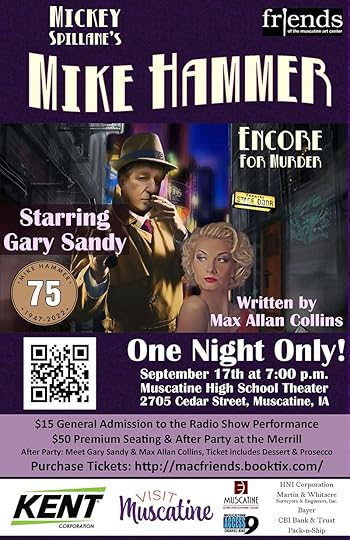 * * *
* * *Crusin’ played its final gig of its season at the Art Center’s annual Ice Cream Social. The crowd was large and appreciative on a lovely day. We were very lucky this year as all five of our gigs were outdoors and nary a raindrop in sight.

The question is, was that the last Crusin’ gig ever?
It’s the old Godfather 3 thing – “Just when I thought I was out, they pull me back in!” With one notable exception, these were all excellent gigs, very well-received, and the last several showed this version of the band at its best.
That notable exception was a private party that came up out of nowhere, which we took because nobody could think of a reason not to. I was of course unaware that I had gone back into Afib and was sick as a dog all night, wishing I were anywhere else. But playing in a band is always that way – you have a miserable experience, and want to bail from the whole damn thing; then you have a fun, great night and amnesia about the bad gig sets in.
I continue to have an ambition to do one last original material CD. We began working on one the year before the pandemic began and rehearsals shut down. And these last two summers we’ve just had enough on our plates to get prepped to make our limited schedule of appearances in the summer.
On top of that – after an unexpectedly rough week following the cardioversion procedure designed to get me out of Afib (the three previous times had taken only a day from which to recover) – I am now feeling fine. Like Nixon, tanned, rested and ready.
So I find myself considering an encore for Crusin’. It’s hard to let go of something you’ve done since (choke) 1965.
* * *Here’s an interesting review of Batman – Second Chances, which collects much of my Batman work.
I haven’t seen it yet, but here’s a magazine you can pre-order with a new Collins/Beatty Ms. Tree interview.
I’m quoted in this terrific look by the great J. Kingston Pierce (of Rap Sheet fame) at half-hour detective TV shows of the 1950s.
Finally, here’s an interesting review of Quarry’s Blood by a reader familiar with the first few novels colliding with the much older Quarry of this one. I have a response in the comments.
M.A.C.
August 16, 2022
Cancellation, Liquidation & Other Heart-Stopping Adventures
Barb and I have had to cancel our Bouchercon registration and we are sad and sorry we won’t be seeing any of our friends and fans who might be in Minneapolis in a few weeks. The reason for this is discussed below, but I wanted to get the word out right now that we won’t be there (we’d been scheduled for several panels).
We’ve had our first review for the upcoming (Oct. 4) Antiques Liquidation. It’s from Publisher’s Weekly, and it’s a good one. Here it is:

Antiques Liquidation
Barbara Allan. Severn, $29.99 (208p) ISBN 978-0-7278-5091-1
At the start of Allan’s madcap 16th Trash ’n’ Treasures mystery (after 2021’s Antiques Carry On), flamboyant septuagenarian Vivian Borne – honorary deputy sheriff of Serenity, Iowa, antiques dealer, and magnet for murder – awakens her long-suffering 33-year-old daughter, Brandy, at 2 a.m. for a questionable meeting early that same morning with sleazy auctioneer Conrad Norris to purchase dead stock (aka “old unused new merchandise”) for their shop. Vivian blithely ignores the dangers of entering a decrepit warehouse once owned by Lyle “the Liquidator” Dayton, who mysteriously disappeared years earlier. Vivian uses some dirt she has on Norris to blackmail him into letting her cherry-pick from the stock before he auctions it. When Norris ends up dead atop an elevator after the auction, Vivian is determined to solve the case. With a reluctant Brandy and her fiancé, Tony Cassato, Serenity’s chief of police, Vivian investigates a lengthy list of suspects with reason to kill the double-dealing auctioneer. Can Vivian and Brandy expose the murderer before he permanently liquidates them? Humorous asides and loads of antique lore will please series fans. Allan (the pen name of Barbara Collins and Max Allan Collins) delivers the cozy goods. Agent: Dominick Abel, Dominick Abel Literary. (Oct.)
In addition to this being a nice review, it’s nice to be reviewed at all with an entry in a long-running series. Reviews no longer come automatically from the trades (Publisher’s Weekly, Kirkus, Library Journal, Booklist) for the long-running Mike Hammer and Quarry novels, and we feel lucky for the attention.
In our local area, the news about Gary Sandy coming to town to star as Mike Hammer in a radio-style production of Encore for Murder has hit local media. Check it out.
In the meantime I have been working with my old pal Phil Dingeldein on other 75th Anniversary of Mike Hammer matters, specifically recording and editing a wraparound for the restored 1954 Brian Keith TV pilot that will be part of the ClassicFlix release of the 1953 version of I, the Jury. As I’ve mentioned here before, that release will really be something special – 4K, Blu-ray and (for those with capability) 3D. My commentary has been edited and is ready to go.
Additionally, Phil and I are working on the expanded version of my 1999 documentary Mike Hammer’s Mickey Spillane. I’ve already recorded some material for that, and more will be shot here in my office. We’re expanding it from 47 minutes to around 60 and will be covering Mickey’s passing and what the Spillane Estate and I have done since then with Mickey’s unfinished work. We have a distributor interested in taking it out to the streaming services.
* * *Despite my insistence last week that my discussing heading into the hospital was not a cry for sympathy – you may recall that sympathy can be found in the dictionary (between shit and syphilis) – a number of you wrote me anyway with your good wishes and support. Thank you for that, and it came in handier than I’d anticipated.
The cardioversion treatment for Afib – jump-starting your heart like an old Buick to get it back in proper rhythm – is a procedure I’ve had several times before, and never had to take much recovery time after. This was different. I was there for a long day, and am told the anesthetized me came off the hospital bed during two shock treatments like a bad comedy effect in a Bowery Boys movie.
Initially it didn’t take, and Barb and I sat in the very nice hospital room in Bettendorf, Iowa, feeling gloomy until, a couple of hours later, the doctor came in and looked at a monitor and pronounced the procedure had taken after all. That lifted our spirits at least as much as the shock treatment had me catapulting off the bed.
But this week has been a long slog. The burns from the paddles created a lot of discomfort by way of itchiness and while my heartbeat was behaving, I remained short of breath and really, really fatigued and flu-ishly achy. Among other things, I considered cancelling my band job on Sunday (it’s Sunday as I write this) and – as indicated above – we had already decided, with my doctor’s prompting, to cancel attending Bouchercon at Minneapolis in a few weeks.
Like Inspector Dreyfus in the Pink Panther films, however, every day in every way I’ve been getting better and better. With Barb and Nate set to help me load and set up my band equipment – and with God favoring us with nice weather for the outdoor event – my band Crusin’ (including me) will be playing later this afternoon.

Crusin’ at Second Sunday Summer Concert Series, August 2022
The band has one more date this year – the Ice Cream Social next Sunday at the Muscatine Art Center – and that will be it…maybe the final two Crusin’ dates period. I have a dream of doing one more CD and presenting it in a farewell appearance, but that may not happen.
Right now I’m happy just to be able to perform. Our previous gig, two Sundays ago (a private party), was where I got really sick and stupidly didn’t recognize that I was in Afib. The reason for that lack of recognition is that Afib symptoms are pretty much identical to Covid symptoms. By the way, anybody over 70 already has most of those symptoms every effing day whether they have Covid or not.
Finally, on this subject, let me apologize for being a big crybaby. My God, what I went through this week was nothing compared to the bad shit thousands, tens of thousands, hundreds of thousands, of my fellow humans suffer every day. So my embarrassed apologies.
* * *I’ve had some very positive things to say about some of the movies and limited series that Barb and I have watched on various streaming services, and we continue to make nice discoveries.
For example, I had no idea Christopher Guest had done another film in the vein of Waiting for Guffman and Best in Show – favorites of ours – but Mascots appears to have been around since 2016. Apparently it went directly to Netflix, which we didn’t have at the time.
Mascots operates on the Best in Show template, a competition in an arena this time showcasing sports mascots. While Eugene Levy and Catherine O’Hara are noticeably absent – they’d have been up Schitt’s Creek at the time – most of the other Guest regulars are present, including the great Fred Willard (now sadly gone), Parker Posey, Jane Lynch, Ed Begley Jr., Don Lake, Jennifer Coolidge, Bob Balaban and John Michael Higgins, among others. Chris O’Dowd from Guest’s HBO series Family Tree is onboard too, and Spinal Tap’s Harry Shearer is the stadium announcer.
Though easily the least of the Guest mockumentaries, it’s still a joy if you like the others. The presentations of the routines by the mascots are beautifully staged, and Guest again walks his unique line between mocking and loving the characters so deeply involved into something inherently absurd. You know, like life.
So that was a nice discovery. Not so nice were the experiences of two series that caught us up and then, boy, let us down. Hard.
The first season of Picard was fine – not on a par with the recent Star Trek – Strange New Worlds, but a Firefly-like set-up with interesting new characters supporting Jean Luc Picard and just enough visits from the Next Generation cast to warm a trekker’s heart.
And then came the second season.
I can sum it up best by saying that Barb – at least as big a Roddenberry-era Trek fan as I am – bailed two-thirds through. Most of the new characters were back but in needlessly reworked fashion. I can’t critique this in detail because I’ve washed most of it from my memory – what I mostly recall is the cast being separated off into groups of two and wandering around a 21st Century city (it’s time travel) uttering meandering dialogue. The worst Trek I’ve ever endured.
The powers-that-be seem to know it, as the third (and announced final season of Picard) is going to feature the original Next Generation cast.
Then there’s The Old Man. I had avoided this FX series because it was a little too Quarry-like in its set-up (that kind of thing always annoys me) and even had several episodes directed by the main Quarry director. But we got caught up in it immediately, with both Jeff Bridges and John Lithgow excellent in a story that had a long-retired CIA agent forced out of retirement. And the first four episodes are compelling, just riveting…and then at first gradually and then picking up speed as it heads off the cliff, this initially fine show goes to crap.
This appears to have happened for a couple of reasons. My understanding is that initially the episodes were faithful to the source novel by Thomas Perry. Then, apparently, it veered away because, you know, what does the person who created the thing know, anyway?
But Covid is at least an accomplice in this descent into Shitistan. Originally scheduled for ten episodes, The Old Man became seven episodes when it shut down, a period during which Bridges got Covid among other even more daunting ailments. He recovered, but the show didn’t. And a good share of it is reflective of Covid precautions: much, much time is spent with people riding and talking in the front seats of cars.
And while Bridges can seemingly do no wrong as an actor, Lithgow goes from understated to full on ham, as he tries to salvage things from a script that makes so little sense the actors appear embarrassed. What began as a fine performance by Alia Shawkat in the first half of the season becomes an almost desperate cry for an acting coach. Not her fault. Bad script. Dismal direction.
My review to Barb, who somehow didn’t bail although her growing disgust became apparent, was to blow a Bronx cheer. A guy my age could really, really use those seven hours back.
* * *The articles about the film of Road to Perdition just keep coming. Here’s a nice one.
And finally this really smart review of The Girl Most Likely (and my definition of smart is, of course, that the reviewer liked the book).
M.A.C.
August 9, 2022
A Sumner/Collins Interview and Where To Find Sympathy
My friend and editor at Titan in the UK – the great Andrew Sumner – did an interview with me about the Mike Hammer novel being published September 13th (Kill Me If You Can) as part of the 75th anniversary of Mickey Spillane’s great private eye.
Andrew has edited the last three or four Hammers, at my request. Several previous editors at Titan – while good, smart people – were not familiar with Hammer or Collins or the quirky way of American tough-guy argot. Andrew is, and he’s been a pleasure to work with.
I will spoil the punchline of the interview by revealing here that I have signed with Titan to complete the Mike Hammer Legacy series with two final Mike Hammer novels, to be published in 2023 and 2024. These final two books will, as have all of the books in this series of Collins completed novels, contain genuine Spillane content.
What an honor and pleasure it has been to undertake this task. It’s not entirely over, because a number of non-Hammer fragments remain that may generate Spillane novels, and there’s even the possibility of a couple of Hammer short stories. But the novel saga of Mike Hammer is drawing to a close, with the shelf of 13 expanding to 29 plus a short story collection (A Long Time Dead) rounding the series to an impressive 30.
I should also thank Otto Penzler at Mysterious Press, who published the first three Spillane/Collins Hammer novels (The Goliath Bone, The Big Bang and Kiss Her Goodbye, all under the Titan umbrella now) as well as the short story collection. Otto’s understanding and appreciation of Mickey and Mike’s legacy will continue with the January 2023 publication of Spillane – King of Pulp Fiction (by James L. Traylor and myself).
This will be a somewhat short update because, frankly, I am dealing with a health issue. I hesitate to mention it because – as with the recent passing of our family dog, Toaster – this might elicit an outpouring of support, good thoughts and even prayers. Which is always appreciated, but I don’t think any of this is a big deal – just the price of living this long and trying to stay active.
One aspect of my heart problems – which my open-heart surgery in 2016 dealt with effectively – is an occasional recurrence of Afib. Some people can handle Afib as a part of their daily lives, but it throws me for a loop. Nonetheless I didn’t realize I’d slipped back into Afib until I took a previously scheduled PET stress test a few days ago.
I’d been dragging around and fighting sleepless nights for about a week, and had suffered through a band job where I could barely tear down and set up and tear down my keyboards, and where my performance was perfunctory at best. Having been through Afib several times before, I should have tipped to it immediately. But didn’t. The stress test had barely begun when the nurse informed me I was in Afib.
Actually, what she said was, “Did you know you were in Afib?”
I said I didn’t, managing not to proceed that with “duh,” as I’d been experiencing every symptom.
Anyway, luckily I am able to go in tomorrow (Monday) for cardioversion, which is essentially jump-starting your heart. Usually it’s just one long day in the hospital. This is Sunday as I write this, and will happen Monday, while this Update appears on Tuesday, so good wishes are not necessary – the shooting match will be over.
I share this with you because, obviously, it’s on my mind. I began writing F.O.M.A.C. (Friends and Family of Max Allan Collins) updates decades ago. This was prior to using the Internet for that purpose – these were literal, physical newsletters that went out once or twice a year, and announced bookstore and convention appearances, and let readers know what novels and comics and even movies were coming out.
At some point – and I have zero memory when – we moved this to the Internet, and again the occasional postings were prompted by appearances and publications. My son Nate suggested the infrequence and irregularity of these updates were not helpful and nudged me into more regular postings. Before long we switched to weekly ones.
Frankly I focused on promo of my work, links to favorable reviews, and not much else for a while, until again my son said I needed to be more personal (something he came to regret to a degree). Nate particularly encouraged me to pull back the curtain on the writing process – talking about how Nate Heller is researched and so on. To mix metaphors, to share how the sausage is made.
Now and then I wandered into politics and again my son warned me against it, and he was right. I weaken now and then, and still make no secret of my politics; but no real political opinion stuff appears here. What I drifted into was reviews and other discussion of popular culture, which I enjoy doing and get good response doing it. A more personal side began creeping in.
I was a big fan (and a friend) of Harlan Ellison’s. I told him often that I loved his collections of stories where he introduced and discussed his own work. I really loved (and love) that sense of who was behind the fiction being part of the mix. This has crept into my books, with introductions and afterwords (particularly of reprinted material), containing autobiographical looks at how novels or stories came to be written – for example, the convoluted tale of how Nolan began at Curtis Books in the early ‘70s, with only two of the five books seeing print by that company before they were swallowed up by Popular Library; and how the remaining three and one new one were picked up by Pinnacle in the ‘80s. And how Don Pendleton thought I was stealing from him because Nolan rhymed with Bolan.
And the Nolan story is a lot more complicated than that, but my essays about it can be found in the Hard Case Crime two-fer collections of the novels.
A turning point came in 2016 when I had open-heart surgery and wrote about the experience here. My writer pal Steve Mertz said that was some of my best stuff ever, and he knows whereof he speaks. So I have been more frank here, although my son from time to time protects me when I get out of hand…as when recently I went ballistic about a review that irritates me and he reminded me it was a three-year-old review and I should probably get over it. So we cut that bit.
Maybe someday I’ll collect some of the best of F.O.M.A.C. and let the censored stuff see the ill-advised light of day.
Anyway, this is a long-winded way to say that I don’t write about sad and personal and medical things here to get your sympathy. As my late friend Paul Thomas used to say (quoting his father), “If you want sympathy, it’s between shit and syphilis in the dictionary.”
Nonetheless, I want to thank you for reading these blog entries. With luck, I’ll see you here next week.
* * *This is an interesting column by a reader who has picked up Girl Most Likely and is experiencing it via the book and audio being able to sync up. She promises a review of the novel soon.
In the current entry of the Rap Sheet, J. Kingston Pierce talks about my announcement of Too Many Bullets, and how it will deal with “the 1968 assassination of Robert F. Kennedy, he explains, but will also ‘cover both Jimmy Hoffa and Sirhan Sirhan,’” and how it may be the last Nate Heller novel. Turns out I am an unreliable narrator, because (with editor Charles Ardai’s blessing) I have already decided to turn Too Many Bullets into two Heller novels. Too Many Bullets will be the RFK assassination novel. The as yet untitled Heller after that will go back and deal with the Jimmy Hoffa story. This came about because – as is always the case – the research has led me places I did not expect to go.
Fifteen movies are recommended here, and one of them is Road to Perdition.
And Road to Perdition is also one of the best movies that have moved to Amazon Prime.
M.A.C.
August 2, 2022
Bargains, a Nice Review Sparks a Rant & R.I.P. for Toaster
We did not attend San Diego Comic Con this year. Maybe next. We tentatively plan to be at Bouchercon (Barb and I, and Matt Clemens too, unless Covid scares us off).
Check out this Wild Dog cosplay pic from an unknown recent convention.

A 12-year old girl at a comic con appears as Wild Dog!
Some new bargain offers for Kindle on several of my titles are about to hit.
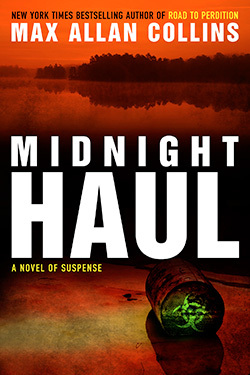

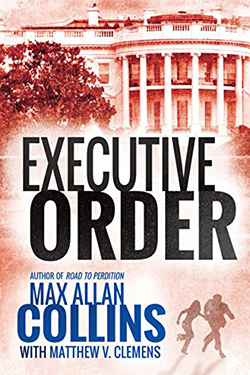

Midnight Haul will be promoted via Kindle Daily Deal starting 8/6/2022 and running through 8/6/2022 – 0.99 USD during the promotion peril. Midnight Haul is a 1986 eco-thriller with a Mallory-esque protagonist.
Supreme Justice will be promoted via Mystery, Thriller & Suspense Kindle book deals starting 8/1/2022 and running through 8/31/2022. 1.99 USD during the promotion period. This is the first in the Reeder and Rogers political thriller trilogy.
Executive Order will be promoted via a $3 toward a selection of Kindle books starting 8/1/2022 and running through 8/31/2022. (I don’t quite know what this promotion is exactly, but maybe you do.) This is the third in the Reeder and Rogers political thriller trilogy.
The Reeder and Rogers books were just a little teensy weensy bit prescient. Supreme Justice (2014!) was about Roe V. Wade being overturned and somebody targeting Supreme Court justices for death to change the make-up of the court. Fate of the Union (2015!) was completely unbelievable – a megalomaniac billionaire runs a populist presidential campaign, breaking countless laws along the way (what will that Collins and Clemens think up next?). Finally Executive Order (2017!) finds the Secret Service participating in an attempted coup of the U.S. government (what, are Collins and Clemens kah-ray-zee?).
* * *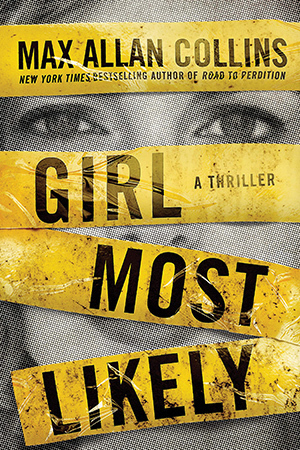

Longtime reader Joe Maniscalco has posted a Girl Most Likely review on both Goodreads and Amazon, but I’d like to share it with you here, as well. (By the way, as I write this both Girl Most Likely and Girl Can’t Help It are still offered at the 99-cents Kindle price on Amazon.)
I’ve been reading Collins’ novels since the early 1980s, beginning with protagonists, Quarry, and Heller. Tough guys all of them. Collins has even written Westerns and completed unfinished novels by Mickey Spillane. This may be his first (or at least the first for this reader), where the protagonist is female—a young Midwestern police chief who is working with her retired police officer father.
Girl Most Likely is a crime thriller that I chose to read on the plane to my own high school reunion. Could a serial killer be looking for victims who’ve attended a specific high school graduation class? And if so, why?
This appears to be one of Collins’ more traditional mystery novels with its closed circle of suspects, and an almost traditional detective team.
I selected this Max Allan Collins after recently reading his Road to Perdition trilogy and waiting for his next Heller historical mystery. I shouldn’t have waited so long. Collins seems to be exercising his writing chops with this different, but worthy addition to his resume.
Obviously I appreciate a nice review like this, but it does spark some thoughts I’d like to share.
I am well aware that not all readers are willing to try something different from a writer whose work they’ve liked in another vein. Joe is clearly an exception. Still, I do have a fair number of readers who, for example, like both Quarry (the most overtly noir) and the Antiques novels (the shamelessly if tongue-in-cheek cozy mysteries written with my wife Barb as “Barbara Allan”).
Joe viewing Krista Larson as my first female protagonist indicates he is not aware of the Antiques novels, with Brandy Bourne and her mother Vivian sharing lead honors, or of the Terry Beatty co-created comics feature Ms. Tree (not even in her one prose novel appearance, Deadly Beloved). He would probably like Ms. Tree and be open-minded enough to try the Antiques novels.
But, as I indicated, I understand not everyone can handle a writer doing different things. Barb, for example, writes very dark short stories and has for years; but the Antiques novels she and I write together are comic and fairly light. My long list of novels and stories are all over the place – the Mallory novels have been described as medium-boiled, Nolan is third-person crime, Quarry is first-person crime, the Eliot Ness quartet strictly police procedural, same with CSI obviously, the two Mommy novels psychological horror, Reeder & Rogers political thrillers, the Harrow novels with Matt Clemens are serial killer books…and so on.
For a lot of years – I am slowing down in my dotage – I published five, even six books a year. I did this because I had the temerity to want to try to make a living. This included movie novelizations and TV tie-ins, about which some discriminating readers might hold their nose in the air and squeeze those noses delicately shut with refined fingers and judiciously avoid. Back in the real world, I was making a living and getting on the New York Times and USA Today bestseller lists with a lot of those novels, the varied genres of which allowed me to stay fresh, learn new things, and work muscles I didn’t know I had.
No publisher would publish five new Quarry books in a year. Nobody wants more than one Mike Hammer novel a year. I can’t write more than one Heller every couple of years or so because of the degree of difficulty, starting with voluminous research. And, anyway, I need to stay fresh. Stale is bad.
This is something of an old argument, of course, and a moot point really, because at my age doing four or five or six novels in a year just isn’t going to happen. But just understand that I don’t expect you to like everything I write. I love it when you do, but that’s not a requirement. Still, if you like my work, in the unlikely event you find something of mine you don’t like, try to keep it to yourself.
Is that really asking too much?
* * *Last week I wrote about Paul Newman, Joanne Woodward, Tom Sizemore, Chris Penn, Quentin Tarantino, Bill Lustig, Larry Cohen and (not surprisingly) Mickey Spillane. But in the comments and e-mails about that update, nobody talked to me about any of those famous humans.
Everybody talked about Toaster Collins.
My tribute to our late little family dog, a lovably demented Blue Heeler, touched a lot of heart strings. I wrote my blatantly sentimental piece knowing it was not exactly expected of a hardbitten dispenser of noir like me. But I did it anyway, and my son Nate – Toaster’s real master – provided some lovely pictures of the little dog, representing well this small life that impacted our family in such a big way.
Some of these comments were posted last week (and you can go read them), but others came by way of e-mails. I even heard from some of my editors. I found myself reflecting on this outpouring – these were condolences that might have been about my mom or dad passing. And I asked myself how these creatures, these pets that can be so loving and so demanding, who have us growling when we have to board them to get a few days away, who want to go outside at the least convenient moments, who beg for food and attention but always on their terms…who needs them?
Apparently a lot of us do.
When I reflect too on how terrible we are to each other, everything from losing friendships over partisan politics to yelling at stupid drivers, I marvel at how these non-human creatures touch our humanity in a way other humans seldom do.

 * * *
* * *Here’s yet another indication that the film of Road to Perdition is becoming an American classic.
And Perdition is ranked one of the best 30 movies playing on Paramount-Plus right now.
Finally, Scar of the Bat is included in this article about Batman appearing in different eras.
M.A.C.
July 26, 2022
A Farewell and Several Unexpected Resonances
The unsung hero of my weekly update/blogs is my son Nathan. He does all the layout and catches (most of) my goofs in the text. Regular readers of these updates may be aware that Nate is a Japanese to English translator and has been doing manga, video games, and novel translations for well over ten years.
One of his claims to fame in his specialized field is translating the novel Battle Royale (which as Quentin Tarantino recently pointed out was the, shall we say, inspiration for Hunger Games) (and Quentin should know about such things).
Nate current ongoing gig is translating the popular manga Jo Jo’s Big Adventure for Viz. By way of demonstrating just what a big deal this is, take a gander at the accompanying photo taken at FYE in Terre Haute, Indiana.

Nate is a terrific writer in his own right (and write) and if you have any interest in manga, checking out JoJo would be a good idea. [Especially from Part 3 onward (where I took over).—Nate]
* * *My novels Girl Most Likely and Girl Can’t Help It are still 99-cents each on Kindle till the end of this (July) month. Give ‘em a try!
* * *I have mentioned here several times that my frequent assistant director on my indie film productions, the late Steve Henke, would always complain that my dark noir subject matter inevitably softens at the conclusion, where I betray a streak of sentimentality, and there was nothing anybody could do about it.
That’s true, and I am about to talk about the death of our family dog, and you can skip it but you can’t stop me.

Toaster Collins, a Blue Heeler, died last week at age 13 or so. Her name came from the robots on Battlestar Galatica (the reboot). She was Nate’s dog, but when he moved back to Muscatine from Chicago two weeks after he bought Toaster, she became the family dog. The two of them lived for a year or two with us before they set out for St. Louis (and a few years ago returned here). So Barb and I bonded early with the little dog.
And she was a little dog, for a Blue Heeler anyway, the runt of her litter. Not as little as the terriers we’d had previously, but small enough to be a lap dog, and I am proud to say my lap was apparently her favorite. Overall her master, Nathan, was her favorite human; but all of us loved her, man, woman and child, though she drove us absolutely crazy with her craziness.
And she was crazy. For the first eight years of her life (approximately), all you had to say was, “Tree,” and she scrambled half way up the nearest one – climbing up the bark before tumbling back down. She was a greedy little thing, begging at our house, and playing predator floor-cleaner at Nate’s. She was gentle with our two grandkids and loved both Nate and his wife Abby with that unconditional love humans can only aspire to. She was happiest when all of us were together, both households, and would position herself in a doorway to keep a herding dog’s eye on us.

I like to think that, after Nate, I ranked pretty high. That’s clearly delusional, as Barb in this house was Toaster’s source for food – it was a dog bone of contention that at Nate and Abby’s the animal got healthy kibble, and at ours she got turkey breast and whatever she could beg off of us, which was plenty.
She was every bit the family dog. We fell, a while back, into one week at Nate’s house and the next week at ours. For many years Toaster, relentlessly frisky with toys, was playful and could run you a merry chase around the interior of the house. She was shameless in her nearly sexual pursuit of me – no leg dancing, but she would roll on her back and spread her legs…at a distance that would require me to get out of my chair…as she would wave one paw in the air as if summoning me. She would stay on her back until I climbed from my throne and scratched her belly and nuzzled her neck. All I had to do to get a dog kiss was ask for one. No woman in my lifetime, including my wife, has ever been that generous.
Toaster became incredibly neurotic in her later years. Whether separation anxiety or just wanting to go along, she would furiously bark on our every exit. She began to anticipate such exits – all I would have to do was come down the stairs near lunch hour and she would begin to go nuts. Yet when I pointed to Barb’s empty office while she (Toaster, not Barb) was furiously barking, the little animal would obediently go in there to be shut away till Barb had slipped out and I was poised to follow.

Toaster could make a pattern out of a single instance. One morning, Barb – freshening up for the day and being bugged by the creature – gave the animal a treat that became an immediate ritual, the “make-up” bone. If the animal had to go out, she would jump onto my chair (a recliner of course) and march up to my face and stare at me, her wet nose turning mine similarly moist.
Like all dogs, she loved to go for walks. She also loved to bark at bigger animals from the safety of a window. As Barb worked at her computer, Toaster curled on the floor beside her. Sometimes she got up on Barb’s chair and took up most of the space, relegating her mistress to the edge of the seat. At bedtime Toaster managed to expand herself into crocodile length on our bed and assume an angle that left no real comfortable space for any human.

Toaster was nuttier than a Baby Ruth, and why wouldn’t she be? All dogs, house dogs particularly, reflect their owners. It’s more than just Best in Show physical resemblances of pets and masters – it’s personality. She was neurotic as hell. So are we.
She declined over one terrible but mercifully swift weekend. Her presence looked like forever (as Mark Harris said through Henry Wiggins) but of course it was just those thirteen years. And of course in our memories until we, too, are gone.
 * * *
* * *It may be because I am this old that resonances and coincidences keep popping up that seem surprising when you consider that Barb and I stayed in small-town Muscatine, Iowa, all these years.
I was watching True Romance (1993) on the Arrow Video 4K edition, as part of an ongoing attempt to reconsider the early Tarantino films I had disliked at the time, now that I’ve turned into a fan of his later films. He of course did not direct True Romance, but it was an early script.
If my memory serves me (and I admit it often does not), when I was working in 1993 on The Expert (1995) with director Bill Lustig and producer Andy Garoni, I was told that True Romance was nearly a Lustig/Garoni production. Tarantino – transitioning from video store clerk to auteur – was in their orbit, but then Reservoir Dogs (1992) got made and things began to happen for Quentin, who moved on and took True Romance with him. The script I was writing for them was apparently their next project.
Larry Cohen, who wrote and almost directed I, the Jury (1982), was a filmmaker I admired; he had written for Lustig/Garoni a screenplay for Brute Force (a remake of the Jules Dassin noir), which evolved into The Expert. Cohen had fulfilled his contract, but the director and producer did not like his screenplay (I never got through it).
So basically I was the third writer they’d been dealing with lately, the previous two being Quentin Tarantino (wooed away by bigger-time filmmakers) and Larry Cohen (who had dropped the ball on his script for them). It should be noted that previously Cohen had written Maniac Cop 1 and 2 for Lustig and later would do Uncle Sam (1996) with the director. Why Cohen’s script for Brute Force was so weak I have no idea, because he was usually an adept if quirky screenwriter.
All of that is a long preamble to something short. In watching True Romance (which I liked this time around), I was stunned as were most people revisiting that film by its incredible cast, filled with actors who would go on to famous, like James Gandolfini, Samuel Jackson, and Brad Pitt. I’d forgotten that Tom Sizemore and Chris Penn were in the film, let alone that they played a team of LAPD detectives in it.
So here’s the resonance. Sizemore played Quarry (as “Price”) in The Last Lullaby (2008) and Chris Penn was a guy Barb and I had dinner with once. Penn was a guest, as were we, at a Southern arts festival, the exact year and even place having fallen prey to my spotty memory. But we had a nice evening meal with him, though he seemed vaguely irritated by how in tune Barb and I were, which is not the usual reaction we invoke.
None of that is a big deal, but to be watching one of Quentin Tarantino’s break-out movies, with memories of following in his footsteps on my 1993 Hollywood adventure, and seeing the only actor to date who has played Quarry in a feature film and Sean Penn’s late brother, who Barb and I had a memorable but slightly odd dinner with once upon a time…well, it had me blinking.
This kind of thing happens to me more and more. Barb and I, over the weekend, watched an excellent six-part HBO documentary about Paul Newman and Joanne Woodward, The Last Movie Stars. Into the Newman/Woodward story, actor Ethan Hawke inserts himself – and the cast he recruited to play voiceovers of the participants based on a transcript of a destroyed documentary Newman began in the 1990s – in a manner that should come across as self-indulgent and intrusive; but isn’t. The approach provides a picture of how in post-WW 2 Hollywood movies evolved (and devolved) over time, but mostly a revelation into how gifted actors think. The Zooming participants included (but are not limited to) George Clooney (as Newman), Laura Linney (as Woodward), Sam Rockwell, Sally Field, and Vincent D’Onofrio, with Brooks Ashmanskas spot on as Gore Vidal. Not part of the recreation cast are interview subjects David Letterman, Martin Scorcese, and Mario Andretti, as well as Newman’s adult children and grandchildren.
The revelation for me was understanding that Newman had brought to his performance in Road to Perdition his warm relationship with his two male grandchildren. The two boys in Perdition are of course surrogate grandchildren of Rooney/Looney, and Newman’s tragic turbulent time with his late son Scott informs his relationship with troubled son Connor (Daniel Craig)

Both Newman and Woodward are fascinating artists. Newman, a limited one in his earlier phases, played off his natural charm and good looks and became a movie star. Woodward’s instinctive but unerring acting chops made her a movie star first, but also a major actress while Newman seemed a commanding screen presence…but no more. There’s a middle period for Newman, where he finds himself in the humor of Butch Cassidy and the Sundance Kid (1969) and The Sting (1973), and reveals himself in the political fervor of the unfortunate WUSA (1970) and the well-realized Slapshot (1977). He does occsionally retreat into movie star mode for the good Harper (1966) follow-up, The Drowning Pool (1975), and such hollow victories as The Towering Inferno (1974) and Absence of Malice (1981), the latter with its awkward, misjudged relationship with a stridently too young Sally Field. From this came the triumph of The Verdict (1982) and the beginnings of star character roles from his Hustler (1966) sequel, The Color of Money (1986), to a little thing I like to call Road to Perdition (2022).
Woodward, interestingly, resented the loss of her movie stardom to stay-at-home mother with occasional film forays, but quietly roared back with a succession of award-winning TV movies. She and her husband made 16 films together, and he directed several films she starred in.
As might be expected, this fine documentary included a clip from Road to Perdition (2022). What we did not expect was that the clip chosen would be the scene Barb and I had witnessed being shot on our day on set.
Another resonance came from Newman’s first starring film, The Silver Chalice (1954), being the Biblical turkey that producer Victor Saville cynically used Mickey Spillane box office to fund. This is a topic much explored in the forthcoming Spillane – King of Pulp Fiction….
* * *Check out this lovely essay on the film version of Road to Perdition.
Here is a great write-up about my Dick Tracy novels on a Tracy film website.
Finally, back on the Road to Perdition, here’s an Entertainment Tonight piece I somehow missed; worth looking at.
M.A.C.
July 19, 2022
A Darling Deal, and Heller on My Mind
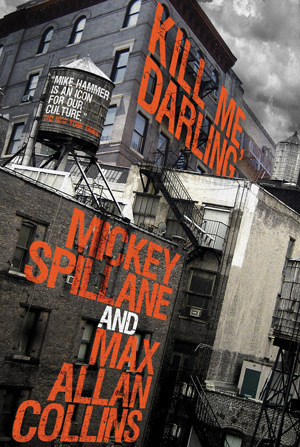
E-Book:





Another book deal has popped up, this time BookBub, and it applies to Kill Me, Darling, one of my favorite of the posthumous Spillane collaborations. I was working from a false start on The Girl Hunters where Velda’s disappearance didn’t have to do with Russia and espionage, but rather Florida and vice. (So in the Hammer canon Velda now disappears twice…not counting kidnappings.)
Anyway, I don’t understand BookBub and if someone wants to straighten me out, I’m fine with that. But it would appear this deal lasts for about a month. Like the still ongoing Girl Most Likely and Girl Can’t Help It offers, Kill Me, Darling is 99-cents on e-book. Unlike the Amazon deal, this extends to Nook and other e-book platforms.
Here’s how BookBub describes Kill Me, Darling:
From the authors of Murder Never Knocks. Private investigator Mike Hammer heads to Miami to find his ex-lover Velda — and figure out her connection to the disturbing murder of her old colleague. “Mike Hammer is undeniably an icon of our culture” (The New York Times).
$0.99 (regular price $7.99).
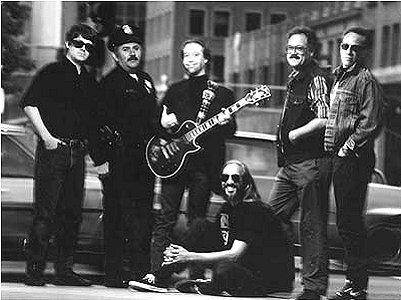
You may have seen my Seduction of the Innocent bandmate Steve Leialoha’s query to me in the comments last week, regarding my current project, Too Many Bullets, Nate Heller looking into the RFK assassination. He asked me if I’d ever talked to Miguel about the night of the assassination at the Ambassador Hotel, saying that Miggie and his mom were there that night.
This was news to me, and I kicked myself, because I’ve known for years I would eventually do Bobby Kennedy, and I never discussed it generally with Miguel. Why would I? You might ask.
Well, Miguel was a big Nate Heller fan. He always requested signed copies to read on set in his trailer (actors have a lot of down time). We talked Heller a lot. We were hoping to do a movie at one point with him in the lead (the novella Dying in the Post-war World was written with that in mind). Didn’t happen but I sure do wish it had.
Miggie’s (and my) pal Bill Mumy, a fellow Seductive One, was…and probably still is…a Heller fan, too. Like Miguel, he has read Heller novels during on-set downtime, and after all he wrote the song “True Detective” for our CD, The Golden Age. I’m proud to have these two among Heller’s supporters. And it hurts that Miguel didn’t get to read any Heller past Ask Not. Maybe, somewhere, Miggie and Bill Crider and Ed Gorman are in a book club, keeping tabs on me.
Chris Christensen, the other Seduction bandmate, also reads Heller, or anyway he used to. Chris did the music for my documentaries Mike Hammer’s Mickey Spillane and Caveman: V.T. Hamlin and Alley Oop). Very talented guy, and like all the Seductive Ones nice and fun.
If you were unaware of my friendship with Miguel, or even if you were and this is old news, you may wish to read this post from January 2017. It’s one of my favorites.
That Miguel could have shared his memories about a tragic, historic night about which I have yet to write gives me an extra pang in an already sensitive part of my psyche. But it also points out how weird the experience of writing Nathan Heller can be.
Miguel and his mom (Rosemary Clooney!) had been at the Ambassador Hotel that wonderful-turned-terrible night, and in an odd way that connected me. I already had an odd Kennedy connection because Jackie Onassis had been my editor on a book I co-wrote with a political figure (a ghost job). I had spoken on the phone with her many times and got to know her in that “phone friendship” way that can be very real. I have a letter she wrote me saying what a great job I did on the book. My University of Iowa mentor, Richard Yates, had been a Bobby Kennedy speech writer, as I learned after I plucked a copy of The Enemy Within off my mentor’s shelf and saw that it had been warmly signed to him. My collaborator Dave Thomas is a fellow assassination buff who knows Paul Schrade and promises to connect me with him. Paul Schrade was standing in back of Bobby Kennedy that night and also got shot in the head, but survived and is now 97 and still researching the case he was in the middle of.
This brings up an interesting point or two. I never know, in doing a Heller, whether I should talk to living participants in the cases I explore. They tend to have their own agendas and I can get caught up in them. For years after writing Stolen Away, I got phone calls from two of the men who thought they were the Lindbergh baby (and one might have been). I need to have my own point of view. My own take.
The other thing is weirder yet. Barb and I were on our honeymoon in Chicago – we were married on June 1 – when the Robert Kennedy assassination occurred in the early hours of June 5. We were staunchly anti-war and were RFK supporters. The news, made strange by not being home at the time, hit us hard, but…and this is the weirdest thing…I remember that I felt (can’t speak for Barb) that American political assassination had become just something to be expected. I was in high school when JFK got it, and not long before Bobby was killed MLK had been taken down, and I was at least vaguely aware of Malcolm X being in the same category. I remember thinking, “So this is how it’s going to be now.”
Maybe the lone nuts decided to find a new hobby (they certainly have one now). Or maybe the powerful figures in the darkness moving chess pieces decided their moves were getting too obvious. But the next time I had a similar feeling was on Jan. 6, last year. I paused writing in my office and went downstairs to get something to drink, and flipped on the TV, and saw Trump’s mob crawling over the face of the Capitol like bearded ants.
And with a shrug I said softly to nobody, “That’s about right.”
It looked like this was how it was going to be now.
Getting back specifically to Nate Heller, my overriding job with all of these cases – unsolved or controversially solved – is to write a hard-hitting private eye novel, with the humor and sex and violence that people expect out of me. That I expect out of me. Part of a Heller novel can be disturbing and even sad, like Chinatown. But it also has to be exciting and interesting and, yes, fun. Like Chinatown.
So how do I face something as terrible, as nation-shaking as Bobby Kennedy’s death without trivializing it?
That is very much on my mind right now. Serving history. Serving my readers. And not doing either of them an injustice.
* * *Here’s a story about Mickey Spillane walking out on I, the Jury in 1953. Maybe it’s true. The sentiment on his part is accurate. But the movie’s actually pretty good.
The great James Reasoner writes about the collection of the Mike Hammer comic strip that I edited and introduced for Hermes Press a while back.
Nice Road to Perdition (the film) essay here.
This review looks at Headed for a Hearse by Jonathan Latimer and my introduction (which was written some time ago for an earlier edition, though the writer seems unaware of that). It’s a pretty good essay but drifts into the area of judging yesterday’s fiction by today’s politically correct attitudes. The reviewer better not read the first chapter of Farewell, My Lovely.
M.A.C.

